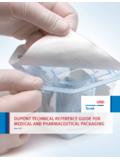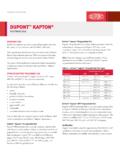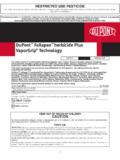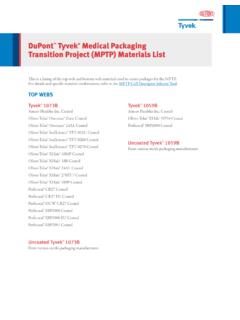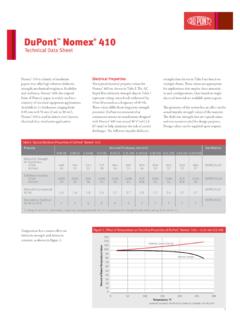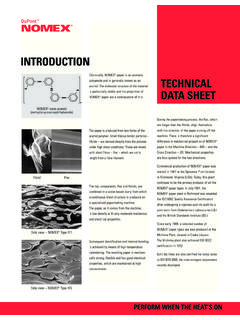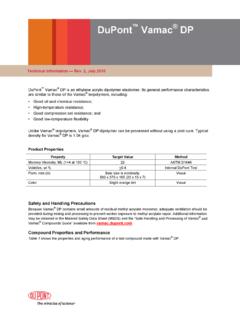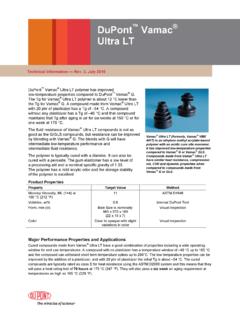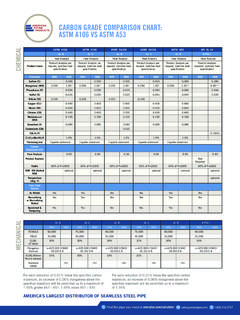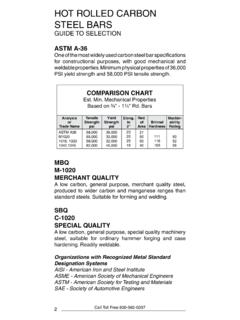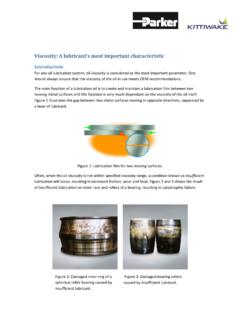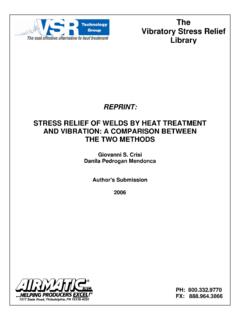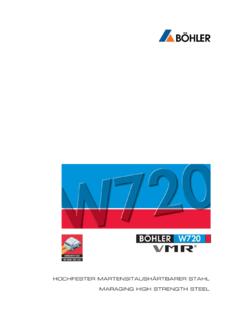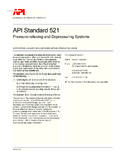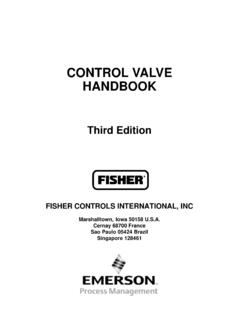Transcription of surlyn chemical resistance - DuPont USA
1 DuPont surlyn . IONOMER RESINS. TECHNICAL INFORMATION: chemical resistance . DuPont surlyn resins have outstanding resistance to both physical and chemical attack. They are also highly resistant to permeation by liquids. However, some aromatic, cyclic, and high eraliphatic hydrocarbon solvents cause swelling and permeate through the resin; therefore, they should be used with caution. The permeation rate of any liquid will vary depending upon the particular grade of resin and wall thickness, as well as the molecular weight and polarity of the liquid. Note: This report applies to industrial applications for surlyn resins and not for flexible packaging applications. Generally, industrial applications involve material thicknesses greater than 20 mil.
2 Flexible packaging applications, by comparison, typically involve thin films and/or thin coatings or laminations to other substrates. The chemical resistance performance of surlyn for these thin, flexible packaging applications may be different than indicated in this report. chemical environmental effects on surlyn resins may be divided into three categories: oxidation, stress cracking, and plasticization. Only oxidation is a chemical degradation; the other two involve the physical properties of the polymer. Oxidizers Oxidizers are capable of chemically degrading surlyn . The chemical effects of even a strong oxidizer may be gradual and may not be measurable over the short term. However, they may be significant over the long term and should be evaluated if continuous exposure is expected.
3 The following materials are examples of strong oxidizers that are unsuitable for long-term exposure to surlyn resin: Nitric acid, fuming Sulfuric acid, fuming (oleum). Aqua regia Chlorine (wet gas). Bromine (liquid). Stress Crack Agents Certain surface-active materials, although they have no chemical effect, can accelerate the cracking of surlyn resins when under stress. This accelerated form of stress failure is called environmental stress cracking (ESC). Although all resins are subject to stress cracking, some are more susceptible to it than others. Certain surlyn grades are specially designed to be more resistant to this type of failure. ESC failure depends on the amount of stress in the resin and, therefore, thermal history and design factors are very important.
4 When designing for known or possible stress crack agents, surlyn grade selection and optimum fabrication techniques ( , for minimum internal stress) must be considered. The following materials are examples of stress crack agents that are unsuitable for long-term exposure to surlyn resin: Methyl alcohol Ethyl alcohol n-Propyl alcohol Isopropyl alcohol Ethylene glycol Plasticizers Certain types of nonaqueous chemicals are absorbed to varying degrees by surlyn resins causing swelling, weight gain, softening, and some loss of yield strength. These plasticizing materials cause no actual chemical degradation of the resin. Some organic solvents such as aliphatic hydrocarbons, chlorinated hydrocarbons, aromatics, and heterocyclic compounds have a strong plasticizing action (10--20% solubility in the polymer).
5 However, most of these solvents are sufficiently volatile, so that if they are removed from contact with the resin, the part will" dry out" and return to its original condition with no impairment of properties. Sodium-type resins absorb less of these solvents than zinc types. Conversely, aqueous solutions will plasticize sodium-type resins more than zinc types. If the end product is unsupported, absorption of either aqueous or nonaqueous product will reduce the product stiffness and may change color and increase internal haze. Testing Is Important It cannot be expected that one chemical resistance data chart will include the effects of all chemicals. Furthermore, the suitability of surlyn depends not only on the nature of the chemical environment, but also on the expected service temperature and stress, the duration of exposure, and whether it is intermittent or continuous.
6 Because so many variables are involved, it must be recognized that standard laboratory tests can give only a general guide as to whether a resin may resist exposure to a specific environment. Therefore, the feasibility of any chemical environment must be determined by extensive laboratory tests carried out under conditions that approximate as closely as possible those expected in service. The following procedure is recommended to determine the suitability of surlyn to resist a specific chemical exposure: 1. Immerse a sample of the surlyn resin in the chemical under study. The sample should be preweighed and immersed at the expected service temperature for a reasonable time. Note: Many of the chemicals under study may be toxic, corrosive, flammable, and/or irritants.
7 In addition, many of the chemicals under study should not be inhaled, ingested, or come in contact with human skin. Therefore, accepted industrial standards should be used when involved with these chemicals. 2. At the end of the test period, the sample should be reweighed to determine if there is a weight gain or loss. In addition, any change in surface hardness should be noted. 3. Check for chemical degradation of the resin by observing any surface crazing, cracking, or discoloration. 4. Tensile properties should be checked by measuring ultimate tensile strength and elongation. Tensile properties will change with percent plasticization. If chemical attack has occurred, a remarkable decrease in ultimate tensile strength should be evident.
8 5. Environmental stress cracking characteristics of the chemical understudy can be determined using ASTM. test procedure D1693 by substituting the chemical of interest for the test liquid specified in this procedure. Guide to chemical resistance The chemical resistance data presented in the following table originated in part from tests conducted at DuPont laboratories and, in part, from reliable published sources. This table is intended only as a preliminary, general guide to the resistance of surlyn to various chemicals. It should not be used by the industry as the basis for final decisions because the specific end-use application, design, and/or conditions of use may have added effects on performance in a particular chemical environment.
9 It is recommended that laboratory testing of the specific end-use application be conducted under expected service conditions. resistance Code Caution Code R Resistant; no indication that serviceability would be impaired. O Oxidizer P Plasticizer V Variable resistance , depending on conditions of use.* A Known stress crack agentb U Not resistant. Not recommended for service applications under any conditions B Possible stress crack agentb a The classification "variable resistance " is very broad. Depending on the nature of the chemical , its concentration, the service temperature and pressure, and the time of exposure, surlyn resin can be either very resistant or very susceptible to attack. Therefore, where surlyn is said to have variable resistance to a chemical , it is critical that extensive pretesting be conducted.
10 B A system using surlyn in exposure to a chemical to which it is designated resistant, but which carries a stress crack identifier (A or B), may be serviceable over a useful lifetime providing the following precautions are observed: A stress crack resistant grade of surlyn resin should be used. Stresses in the fabricated surlyn must be minimized by design and processing. Conditions and limitations of the application should be carefully observed (avoidance of high temperature, etc.). chemical resistance Data surlyn Resin chemical chemical resistance Code resistance Code Caution 21 C 60 C Cautio 21 C 60 C. Code chemical (70 F) (140 F) n Code chemical (70 F) (140 F). B Acetaldehyde (100%) V U Beer R R. Acetic Acid (10%) R R B Beet Sugar Liquors R R.
